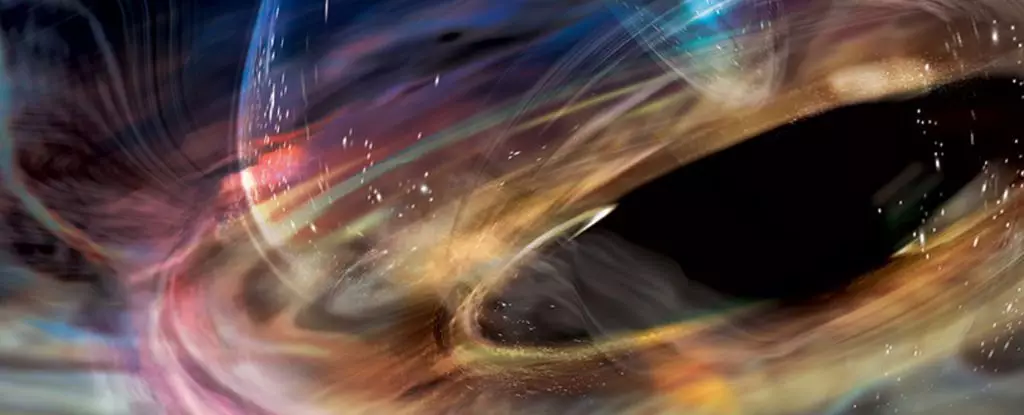Nestled approximately 275 million light-years away from our home galaxy, the Milky Way, lies the galaxy 1ES 1927+654, harboring a supermassive black hole that has ensnared the attention of astronomers around the globe. This particular black hole has been the subject of scrutiny due to its unusual behavior, which has defied conventional astronomical understanding. Recent observations suggest that a white dwarf star is orbiting perilously close to the event horizon of this enigmatic black hole, potentially shedding light on the black hole’s peculiar antics.
Understanding Black Holes and Their Surroundings
Supermassive black holes, like the one residing in 1ES 1927+654, are notorious for their insatiable gravitational pull. While black holes themselves do not emit light, they can be surrounded by vast clouds of cosmic material. As this material spirals towards the black hole, heated by intense gravitational forces, it emits radiation, making it possible for astronomers to study the surrounding environment. This radiation can vary in intensity, revealing critical insights into the activity occurring near these massive gravitational wells. Notably, fluctuations in brightness can signify a variety of phenomena, including stellar collisions or matter being consumed.
In 2018, the black hole in 1ES 1927+654 displayed a peculiar pattern; its corona, a luminous ring of hot gas surrounding it, dimmed significantly before re-illuminating in a display of unparalleled luminosity, increasing nearly twentyfold. Such erratic changes prompted a flurry of speculation among scientists, who considered various explanations, including the possibility of a polar reversal within the black hole itself.
The quest to uncover the nature of the fluctuations surrounding 1ES 1927+654 intensified in June 2022 when data from the European Space Agency’s XMM-Newton space telescope revealed unexpected variability in X-ray output from the black hole’s region. The X-ray emissions were fluctuating by approximately 10% on a timescale of merely 18 minutes. Such swift changes in brightness typically suggest an object is in close proximity to a black hole, perhaps engaged in rapid orbital motion.
As observations continued over the years, scientists noted that the interval between these oscillations crowded closer and closer together—from 18 minutes to under seven. This peculiar behavior starkly contrasted what scientists normally expect from black hole emissions and raised numerous questions about the fundamental nature of black holes and their interactions with nearby celestial bodies.
To decipher the mystery of the inexplicable variable nature of 1ES 1927+654, researchers systematically analyzed the wavelengths of emitted light and the periodicity of the flickering. This rigorous examination led to an intriguing hypothesis: a dense object—most likely a white dwarf star—is spiraling closer to the event horizon. As this object orbits, its proximity to the black hole affects the timing of the emissions, intensifying the bizarre variability.
The researchers suspect that the white dwarf, which is the remnant core of a low-mass star, has been stripped of its outer layers by the black hole’s gravitational forces. Although this might seem like a fate worse than death, the white dwarf’s high density could enable it to resist tidal forces that would typically tear apart a less dense star. This “kickback momentum” might just be sufficient to prevent the white dwarf from crossing the event horizon—a phenomenon indicative of extreme gravitational interactions.
Implications and Future Research
If the researchers’ calculations are correct, witnessing the white dwarf’s gradual retreat from the black hole will provide invaluable insights into the dynamics of our universe. It also opens a door to a thrilling new avenue of research, specifically regarding the viability of celestial objects surviving extreme gravitational influences.
The findings associated with 1ES 1927+654 could significantly enhance our understanding of black holes and the objects that orbit them. They highlight an ongoing narrative in the quest to decipher the extremes of cosmic gravity and its effects on stellar evolution. As astronomers remain vigilant observers of this stellar drama unfolding in the vast expanse of the cosmos, they recognize the potential for unexpected revelations.
The cosmic ballet of the supermassive black hole and its nearby white dwarf could provide profound insights that challenge existing theories and inspire further exploration into the complexities surrounding one of the universe’s most mysterious phenomena. As physicist Megan Masterson aptly sums up, “never stop looking,” for the understanding of these celestial giants is still a work in progress, and each observation could lead to groundbreaking questions about the universe’s workings.


Leave a Reply